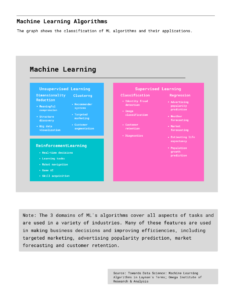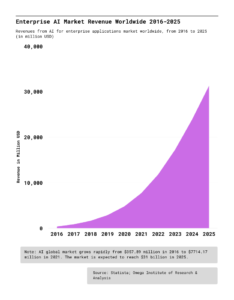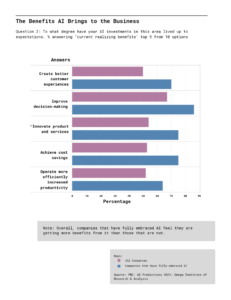- Industries
Industries
- Functions
Functions
- Insights
Insights
- Careers
Careers
- About Us
- Technology
- By Omega Team

Artificial intelligence is becoming a decisive force to push mankind into an intelligent age. The global industry has fully realized the significance of a new round of industrial transformation that is led by AI technology.
History
In 1956, McCarthy, Minsky and other scientists held a meeting at Dartmouth College in the United States to discuss “how to use machines to simulate human Intelligence” and put forward the concept of “Artificial Intelligence” for the first time, marking the birth of the discipline of AI.
1960s. Innovation in the field of artificial intelligence grew rapidly through the 1960s. The creation of new programming languages, robots and automatons, research studies, and films that depicted artificially intelligent beings increased in popularity. This heavily highlighted the importance of AI in the second half of the 20th century. ELIZA, an interactive computer program that could functionally converse in English with a person was developed by Joseph Weizenbaum. Unimate, an industrial robot invented in 1950s became the first to work on a motor assembly line in New Jersey in 1961.
1970s. The 1970s continue to accelerate advancements, particularly focusing on robots and automatons. However, artificial intelligence in the 1970s faced challenges, such as reduced government support for AI research. WABOT-1, the first anthropomorphic robot, was built in Japan at Waseda University. Its features included moveable limbs and the ability to see and converse. A remote-controlled, tv equipped mobile robot was created in 1961, and in 1979 a “slider” was added to move the camera from side to side to enable it to cross a chair-filled room without human interference for 5 hours, making it one of the earliest examples of an autonomous vehicle.
1980s. The rapid growth of artificial intelligence continued through the 1980s. Despite advancements and excitement behind AI, caution surrounded an inevitable “AI Winter,” a period of reduced funding and interest in artificial intelligence. This was the first time that interest and funding for AI research decreases. One of the accomplishments in the 1980s, WABOT-2 was built in 1980. This inception of WABOT allowed the humanoid to communicate with people as well as read musical scores and play music on an electronic organ. In 1988 the inventor of two chatbots developed Jabberwacky, an example of AI via a chatbot communicating with people.
1990s. Due to the development of network technology, the innovation research of artificial intelligence is accelerated and AI became further practical. Inspired by ELIZA, in 1995 Richard Wallace developed chatbot A.L.I.C.E (Artificial Linguistic Internet Computer Entity) with the natural language sample data collection function. Deep Blue, a chess-playing computer developed by IBM became the first system to win a chess game and match against a reigning world champion. AI also started showing in toys. In 1999, a robotic pet dog called AIBO (Artificial Intelligence RoBOt) was introduced by Sony, crafted to “learn” by interacting with its environment, owners, and other AIBOs. Its features included the ability to understand and respond to 100+ voice commands and communicate with its human owner.
2000-2010. The Y2K problem, also known as the year 2000 problem, was a class of computer bugs related to the formatting and storage of electronic calendar data beginning on 01/01/2000. After the fears of Y2K died down – AI continued trending upward. More artificially intelligent beings were created as well as creative media, especially film, about the concept of artificial intelligence.
Innovative products during this decade include an artificially intelligent humanoid robot called ASIMO released by Honda, NASA’s robotic exploration rovers Spirit and Opportunity navigating Mars’ surface without human intervention, and a database called ImageNet used to aid in object recognition software research. In 2009, Google secretly developed a driverless car and by 2014 it passed Nevada’s self-driving test. In addition, the term “machine reading” was coined in 2006 defining it as an unsupervised autonomous understanding of text.
2011-. The current decade has been immensely important for AI innovation. From 2010 onward, artificial intelligence has become embedded in our day-to-day existence. Voice assistants on smartphones and intelligent functions on computers are the kinds of AI products we are exposed to every day. From humanoid robots like Sophia to home speaker assistants like Alexa, AI is advancing at an accelerated rate 2010, the first gaming device Kinect that tracked human body movement using a 3D camera and infrared detection was launched by Microsoft for Xbox 360. In 2011, Apple released the virtual assistant Siri on Apple iOS operating system. In 2013, a research team from Carnegie Mellon University released Never Ending Image Learner (NEIL), a semantic machine learning system that could compare and analyze image relationships.
Data and AI
Effectively building and deploying AI and machine learning systems require large data sets. For example, the development of a machine learning algorithm depends on large volumes of data, from which the learning process draws many entities, relationships, and clusters. To broaden and enrich these correlations made by the algorithm, machine learning needs data from diverse sources, in diverse formats, about diverse business processes. These ML algorithms can be classified into 3 categories and each can conduct various functions in business as shown in exhibit 1.
Exhibit 1: Machine Learning Algorithms

AI and Big Data
By combining the two disciplines of big data and AI, we can begin to see and predict upcoming trends in various industries including IT, retail, hospitality, marketing and healthcare.First of all, with big data and AI technology, companies can improve their forecasting and pricing and identify potential risks. Big data is giving companies the power to spot patterns and trends early. Companies using big data and AI-based approaches especially in retail are ankle to improve seasonal forecasting and reduce errors. Big data-powered models address customer and market risks and provide information on how to allocate people and resources to deal with emerging threats.
With AI and big data, companies can have a 360-degree view of a customer. Personalization provided by AI and big data can improve customer acquisition and retention. Through big data applications, companies can more accurately identify what customers are looking for by observing their behavioral patterns. These patterns can be applied to improve products, brand loyalty and overall customer satisfaction.
Big data-powered analytic can enable companies to improve cybersecurity and fraud prevention. Big data systems have the power to comb through very large quantities of data from transactional or log data, databases, and files to identify, prevent, detect and mitigate potential fraudulent behavior.
In the healthcare industry, the importance of big data analytics and AI are also increasing drastically with the market. With AI and big data, the idea of precision medicine is introduced, lowering the risks of using incompatible treatments and medicines but also building new solutions for fighting disease and delivering healthcare. The value that AI brings to healthcare are improvement in diagnosis, helping develop new drugs as well as reducing costs.
MLOps and AIOps
Machine learning operations is the process of creating, deploying, and ML models. It combines ML and data engineering, ridge the gap between data ops and infrastructure teams to uncover faster, simpler, and more effective ways to put ML into production.While AIOps means AI for IT Operations. It is a term coined by Gartner in 2016 as an industry category for machine learning analytics technology that enhances IT operations analytics. If your company is on a growth trajectory, it’s time to start thinking about how intelligent automation with AIOps can play a crucial role in your IT operations.
AIOps has two main components: Big Data and Machine Learning. Instead of siloed IT data, It uses comprehensive analytics and machine learning strategy against the combined data. Through digital transformation, you can add more business value by saving tons of time and effort, and spending more time on innovation. AIOps adoption can help your organization to get end-to-end visibility into infrastructure and applications.
AIOps collect and aggregate the huge and ever-increasing volumes of operational data generated by multiple IT infrastructure components, applications, and performance-monitoring tools and intelligently identify significant events and patterns related to system performance and availability issues. Then it diagnoses the root causes using the operational data and reports it to IT for rapid response and remediation. It can also automatically resolve these issues without human intervention. Exhibit 2 illustrates how AIOps works for business.
Applications In Various Industries
AI solutions are already being applied in virtually every industry and have proven to be incredibly effective. AI Applications include E-Commerce, Navigation, Robotics, Human resources, Healthcare, Agriculture, Gaming, Automobiles, Social Media and Marketing.
Robotics
Robotics is another field where artificial intelligence applications are commonly used. Robots powered by AI use real-time updates to sense obstacles in their path and pre-plan their journey instantly. It can be used for carrying goods in hospitals, factories, and warehouses, cleaning offices and large equipment and inventory management.Exhibit 2: How Does AIOps Platform Work?

E-Commerce
AI can personalize shopping by creating recommendation engines through which you can engage better with your customers. Virtual shopping assistants and chatbots using Natural Language Processing help improve the user experience while shopping online. AI can also help reduce the possibility of credit card frauds taking place.Automobiles
Artificial Intelligence is used to build self-driving vehicles. AI can be used along with the vehicle’s camera, radar, cloud services, GPS, and control signals to operate the vehicle. AI can improve the in-vehicle experience and provide additional systems like emergency braking, blind-spot monitoring, and driver-assist steering.Current Situation
As shown in exhibit 3, global revenues from AI for enterprise applications are projected to grow from $7.71B in 2021 to $31.2B in 2025 attaining a 52.59% CAGR in the forecast period. Image recognition and tagging, patient data processing, localization and mapping, predictive maintenance, use of algorithms and machine learning to predict and thwart security threats, intelligent recruitment, and HR systems are a few of the many enterprise application use cases predicted to fuel the projected rapid growth of AI in the enterprise.
There has been a 6X increase in the annual investment levels by venture capital (VC) investors into U.S.-based AI startups since 2000. Crunchbase, VentureSource, and Sand Hill Econometrics were used to determine the amount of funding invested each year by venture capitalists into startups where AI plays an important role in some key function of the business. Also, in their database, there has been a 14X increase in the number of active AI startups since 2000.
Even during the COVID-19 pandemic where most industries reduced their total expenses to stay afloat, many companies actually increased their AI investments in 2020. Fields like healthcare have grown their interest and investment in AI, hoping to propel patient experiences forward in telemedicine, digital imaging, and a variety of other areas that give patient greater access to medical resources they need. Widespread adoption of AI is shown in a survey by PWC. Many are reaping rewards from AI right now, in part because it proved to be a highly effective response to the challenges brought about by the COVID-19 crisis. Most of the companies that have fully embraced AI already report seeing major benefits.
Exhibit 3: Enterprise AI Market Revenue Worldwide 2016-2025

Exhibit 4: Enterprise Attitudes Towards AI Application

Exhibit 5: The Benefits AI Brings to the Business

What Can AI Bring to Your Business
The AI vendors are leading the market by providing AI and ML through their popular cloud platforms, enabling companies to incorporate AI into applications and systems without the expense of in-house development. The exhibit shows the top AI venters in the market.
Why choose the Cloud platform to manage your company’s applications and data? Some big platforms can often provide continuous technological updates on big data and AI. Instead of building and maintaining complex data analysis systems, companies can dramatically avoid costs, improve efficiency and increase productivity by hosting them on a platform. These platforms often have advanced infrastructure and cybersecurity solutions.
Today, as companies in the United States are increasingly aware of the potential benefits of AI for business, the choice of AI services is an important topic. Amazon’s AWS, Microsoft’s Azure, Google Cloud, IBM Cloud and other platforms have their own advantages and additional features for companies to choose from. For example, Amazon Echo brings artificial intelligence into the home through the intelligent voice server, Alexa. For AWS, the company’s primary AI services include Lex, a business version of Alexa; Polly, which turns text to speech; and Rekognition, an image recognition service. Google has an industry-leading AI software project in TensorFlow, as well as its own Tensor AI chip project. Microsoft offers a mix of consumer-facing and business/IT AI projects. On the consumer side, it has Cortana, the digital assistant that comes with Windows and is now available for smartphones, and the chatbot Zo.
Exhibit 6: Worldwide Market share of leading cloud infrastructure services providers in Q1 2021

Future Outlook
In the future, the market for AI can be expected to continue to grow rapidly. It is inevitable that more companies will embrace AI entirely, because if you don’t, you may gradually become uncompetitive due to additional cost and inefficiency. AI has become an essential component to boost productivity and assist employees through ML, RPA, cybersecurity and more.
The goal of AI technology is to perform decision-making, problem-solving and understanding human communication. AI always needs to improve and evolve to achieve these functions. The rapid growth of innovation of AI in the future is also foreseeable. The improvement in cybersecurity using AI, better language modeling, autonomous vehicles, and Mark Zuckerberg’s “metaverse” are the breakthroughs we can expect for the coming year.
Subscribe
Select topics and stay current with our latest insights
- Functions